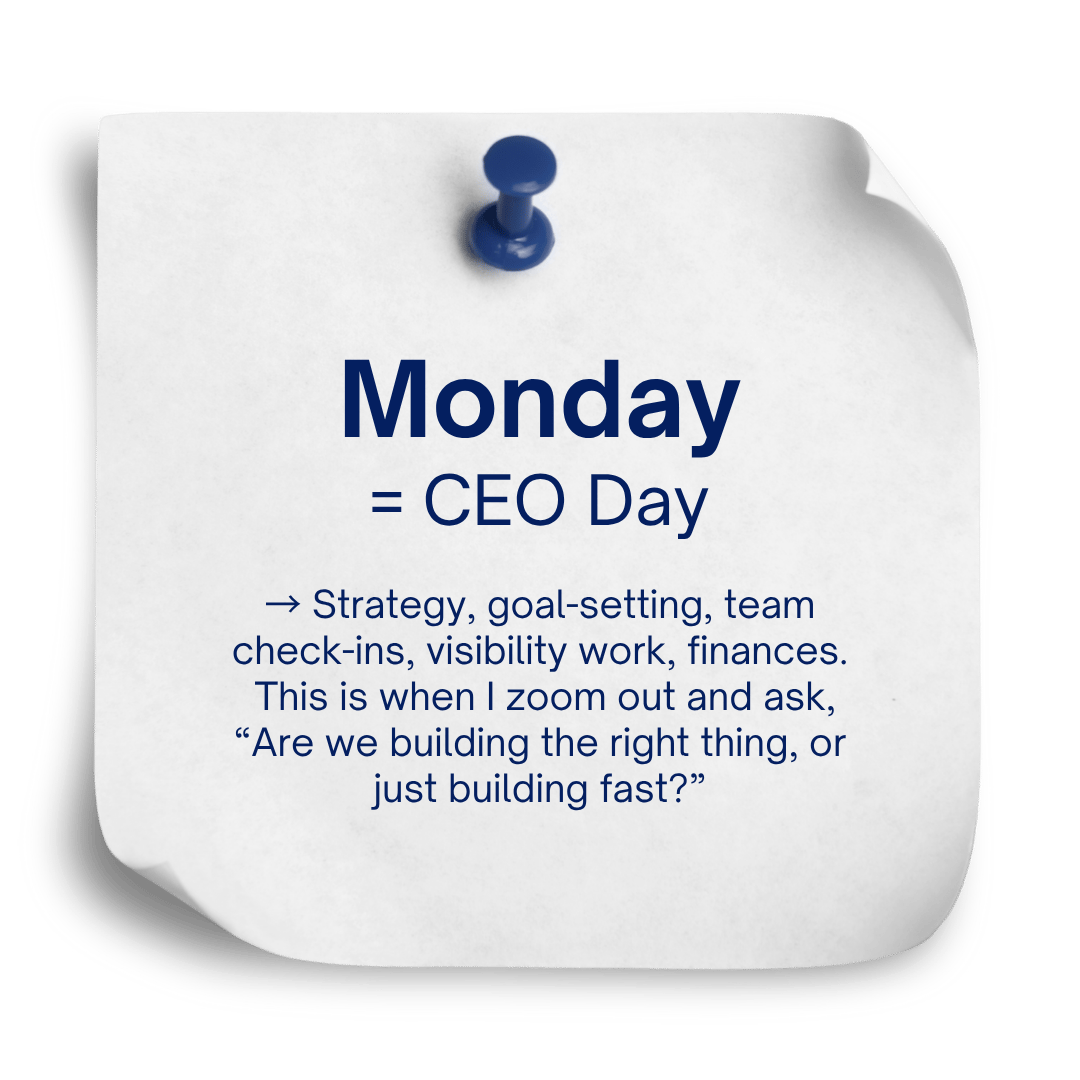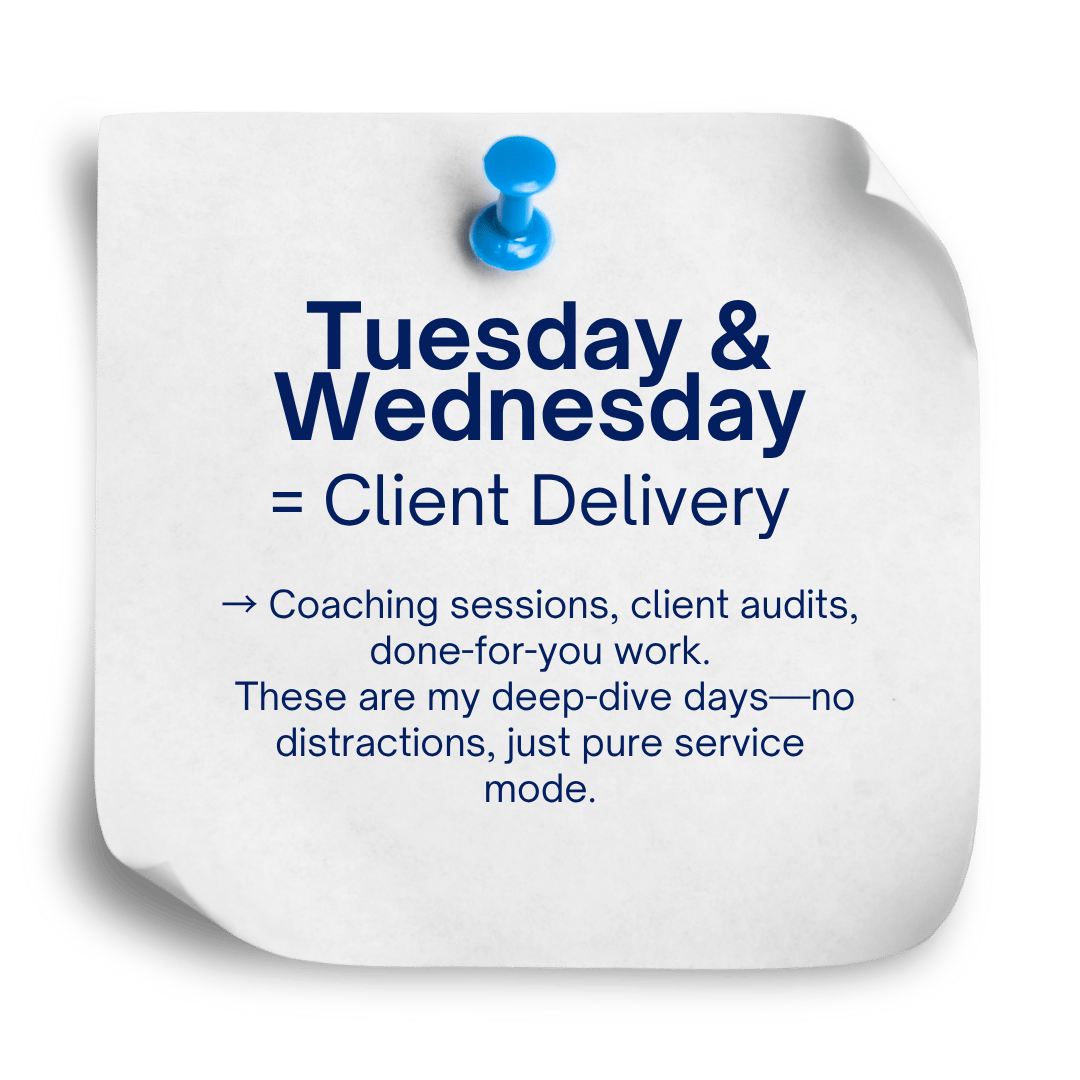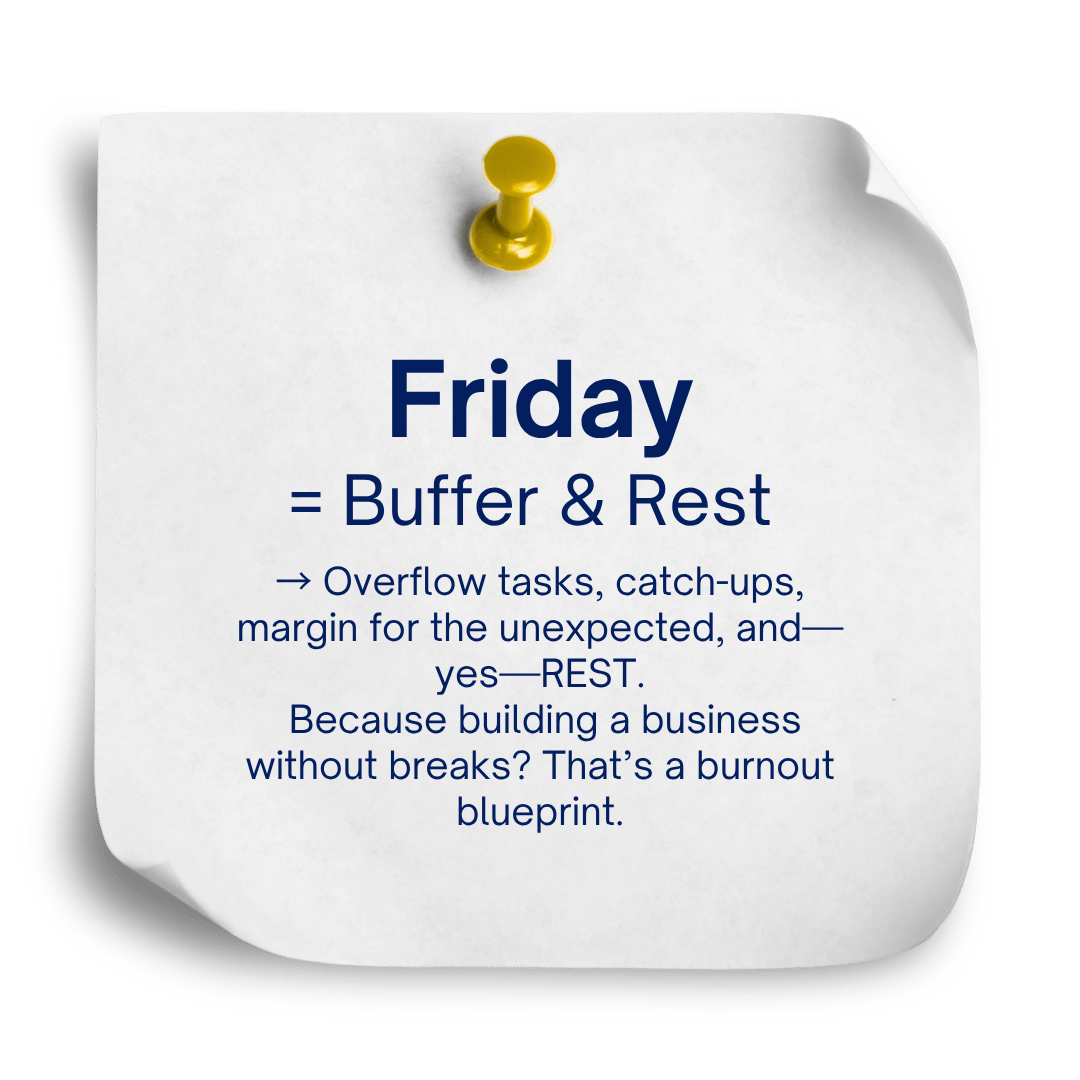- Grit to Growth
- Posts
- How I Created a Scalable Week—Even With a Small Team
How I Created a Scalable Week—Even With a Small Team
Because juggling 37 tasks a day isn’t a business plan—it’s a breakdown waiting to happen.
You don’t need a team of five to grow.
You need a week that works with your energy, not against it.
Let’s get real for a second.
You know what no one tells you when you start a business?
That it’s entirely possible to work a full 40+ hour week and still feel like you accomplished absolutely nothing.
Because when you’re the CEO, the content creator, the service provider and the admin… your time doesn’t just get stretched—it gets shredded.
🧨 Mondays bleed into Tuesdays.
📆 Your calendar looks like a bingo card.
🔁 And the only "strategy" is surviving until Friday.
Been there. Built a business from that place.
And spoiler: it’s not sustainable.
The truth is: most entrepreneurs don’t need more hours or more help.
They need a better week—one that’s designed to protect their energy, prioritize real growth, and scale even with a small team.
Let me show you how I went from "just get through it" to a weekly rhythm that supports my business, my brain, and my boundaries 👇
My “Ah-Ha” Moment
When I first started Grit to Growth, my week was less of a plan and more of a chaotic to-do list with WiFi.
I’d wake up, glance at the mountain of tasks scribbled in five different places, and think, “Okay… let’s see how much I can survive today.”
🧨 No boundaries.
🌀 No themes.
💥 No awareness of my own energy or capacity.
Everything felt urgent. Everything was reactive.
I was booking client calls on top of content time, responding to emails mid-project, and cramming admin work into the 10 minutes between dinner and a social media post.
Sure, I was “busy.”
I was crossing things off like a productivity ninja.
But the needle? It wasn’t moving.
The vision I had for my business—the impact, the freedom, the growth—was stuck behind a wall of random tasks.
I was doing a lot, but building very little.
I was the hamster. The wheel was spinning. And I was tired.
Then one day, mid-spiral (with a half-eaten protein bar and 42 open tabs), I asked myself:
“If my calendar were a reflection of my future business…
would I want to grow it?”
 | And oof. Because what I had wasn’t scalable. So I hit pause. I zoomed out. And I made a decision: |
I wasn’t going to hustle my way to a business I resented.
I was going to design a week that could grow with me—one that supported deep work, protected my energy, and didn’t require a 5-person team to function.
That was the shift.
That’s when I stopped treating my calendar like a cage—and started using it as a blueprint for scale.
My 3-Part Weekly Structure for Service Pros
Let’s be clear: I didn’t create this structure to feel organized.
I created it so I could grow—with less overwhelm, more clarity, and actual room to think. (Wild, I know.)
And no, you don’t need to follow this exact structure.
But if you’re a service provider wearing all the hats, this rhythm will help you move from "just managing" to actually scaling.
1. Themed Workdays
→ Focus = Flow
“Context switching is a silent killer of productivity.”
— Literally every productivity coach ever
One of the biggest game-changers? Giving each day a theme.
Not just for aesthetics—but for focus.
Instead of multitasking myself into madness, I built daily anchors:
  |   |
Mini-Case: One of my clients—a virtual assistant—started implementing themed days and was able to double her client load without working extra hours. Why? Because she stopped jumping between tasks and finally had breathing room.
2. Non-Negotiables First
→ Protect the Asset (that’s you)
“Scaling doesn’t mean doing more. It means doing what matters—on purpose.”
Before I schedule anything, I block time for what fuels me:
✅ Morning walks.
✅ Therapy appointments.
✅ Creative coffee shop hours.
✅ Actual lunch (not just protein bars at my desk).
Then—and only then—I layer in income-generating activities.
After that, admin and overflow get whatever time is left.
This is how you build a business that supports your life—not the other way around.
🧪 Experiment I ran: For two weeks, I scheduled all my “life things” first. I expected to fall behind. Instead? My revenue increased—and my brain fog disappeared. Go figure.
3. Systems Over Scripts
→ Repeat = Automate or Delegate
“You don’t need a bigger team. You need better workflows.”
If a task shows up on my calendar more than twice, I ask:
Can I template this?
Can I record a Loom and hand it off?
Can a system do it better than me?
Here are my go-to tools:
🌟 Pro Tip: You don’t scale by doing more. You scale by doing less of the manual stuff.
Save Your Sanity with Theme Days!
Stop multitasking your way to burnout.
In this quick video, I break down how to assign one focus per day so your brain (and business) can finally breathe.
Not every themed week works the same for every brain.
That’s why I recommend mapping your energy first, then building your structure around it.
The Energy Map Exercise
Design your week like you’d design a workout
Don’t sprint when you should be stretching.
We talk a lot about time management… but not enough about energy management.
Because here’s the truth: You could have the most organized calendar in the world—color-coded and everything—but if your energy doesn’t match the task, it’s just ✨aesthetic burnout✨ waiting to happen.
That’s where the Energy Map comes in.
Ask yourself:
When do I feel most focused and alert? (Morning? After lunch? Late night?)
When am I naturally creative or inspired?
What tasks drain me quickly—even if they don’t take a lot of time?
What activities recharge me?
Then, align your schedule with those energy rhythms.
Example:
I do high-focus strategy on Monday mornings (brain’s fresh).
Client work lands mid-week when I’m in flow.
Content creation happens on Thursday when my brain’s a little looser (and slightly more sarcastic).
Admin? Friday. After snacks.
Even with the perfect plan and perfect energy flow, you can still hit a wall.
That’s when it’s time to stop doing everything and start sharing the load…
When to Hire (Even Just a Few Hours a Week)
Yes, you can scale with a tiny team—but not with a tired you.
There comes a point where DIY becomes DOA: Dead on Arrival for your capacity, creativity, and client experience.
Here’s how to know it’s time to hire:
You’re spending more time managing your calendar than executing what’s on it.
You’ve missed a deadline (or ten) because your inbox is a digital jungle.
You’re saying “I’ll get to that funnel later” every week—and later never comes.
But hiring doesn’t mean onboarding a full-time team of unicorns.
Sometimes all you need is 5 hours a week of support.
Start here:
➡️ Delegate repetitive, low-energy tasks:
Inbox triage
Appointment scheduling
Client onboarding emails
File organization
Social media repurposing
🧪 My personal example:
When I hired my first VA for just 5 hours a week, I gained back 10 hours of deep work time.
That meant:
More strategy
More content
More conversions
→ More peace of mind.
And in case you’re wondering if all this structure stuff actually moves the needle… let’s talk results.
How a Scalable Week Boosts Revenue
Time clarity = money clarity.
I used to think productivity and profit were totally separate conversations.
Turns out? They’re besties.
When I stopped booking my week based on what felt “urgent” and started anchoring it around strategy + energy, everything shifted.
✅ I followed up on leads faster
✅ I actually remembered to pitch
✅ I had creative energy left for content (which drove more traffic and sales)
✅ I had TIME to nurture client experiences (hello, referrals)
“After implementing themed days + blocking my non-negotiables, I closed 2x more sales calls—because I finally had energy to follow up consistently.”
I wasn’t working more.
I was just working smarter—and with space to actually grow.
🧠 Your weekly structure isn’t just about efficiency. It’s about opportunity.
Revenue grows when you stop treating your calendar like a crisis zone—and start treating it like a growth engine.
Scaling isn’t about doing more.
It’s about doing the right things at the right time—with a rhythm that actually respects your energy (and your sanity).
Whether you're a team of one or leading a small-but-mighty crew, your week should work for you—not against you.
So here’s your challenge for this week:
🗓️ Pick one day and give it a theme.
Start small. Stick with it. Watch what happens.

Amber




Reply